Have you seen a cat’s eye at night? What does it look like?
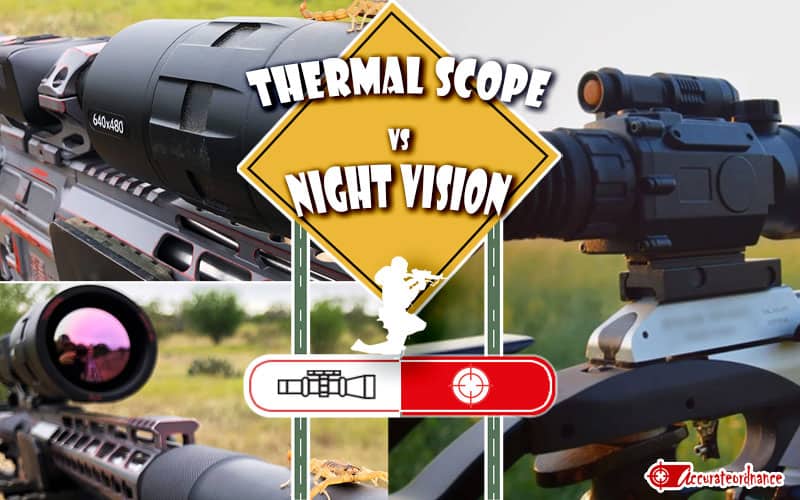
Although cats do not have night vision, unlike humans, they are still able to see in low light conditions. Since humans do not have the kind of eyes that causes light reflection and allows for better night vision, they have the technology! The devices for this technology are called thermal imaging or night vision.
In this article, we will be doing a comparison between night vision vs thermal imaging and discussing the greatest features night vision scopes can offer, as well as how thermal imaging has lately emerged as a rival.
Getting the perfect optic has been a major challenge for both hunters and competitive shooters. There are so many factors to consider while making a selection, such as the type of animal you want to hunt and the ambient light or weather in which your equipment will be functioning.
When there isn’t enough light for your night shooting activities, the only option is a thermal scope or night vision. Which of them is the toughest? Is it night vision or thermal imaging?
Let’s look at the science behind both optics and discuss their advantages and disadvantages.
- What is Night Vision?
- Thermal Imaging Device
- Which is better for you: night vision or thermal optic?
- FAQS
- What is the main difference between thermal scopes and night vision devices?
- Can thermal scopes be used in complete darkness?
- Are night vision devices affected by bright light sources?
- Which technology is better for hunting purposes?
- Can thermal scopes detect camouflage or hidden objects?
- What are the key applications of thermal scopes?
- Are thermal scopes more expensive than night vision devices?
- Do thermal scopes require additional accessories for operation?
- How far can thermal scopes and night vision devices detect objects?
What is Night Vision?
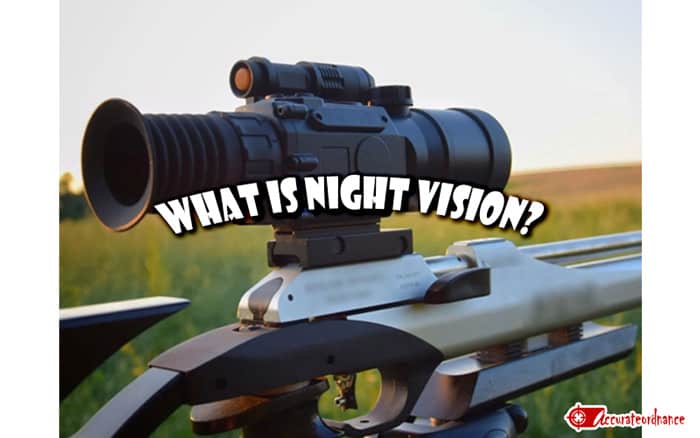
Saying that a scope gathers light is wrong because it can only transmit available light or ambient light. However, certain scopes are better performers than others when it comes to transmitting light, and this is dependent on the optical qualities of the scope such as coating and glass.
Electricity, on the other hand, may significantly improve a scope’s capacity to transmit the little light that is made available through the moon and star. This is why Night Vision goggles, Night vision scopes, and Night vision monoculars are referred to as Starlight Scopes. They can offer images that are brighter than what the human eye can see.
This technology has been around for a while, and it has advanced significantly. Nowadays, we have night vision scopes that are capable of so much that they are not allowed for general use, only for the military. Night vision scopes are similar to standard rifle scopes in terms of optics, but they additionally feature a power source to generate a green or white and black image to allow shooters to see in the dark.
A night vision scope, as the name suggests, is an optic device that allows users to see in the dark. How it works is determined by whether the NV scope is a traditional night vision or a digital night vision scope.
Traditional Night Vision
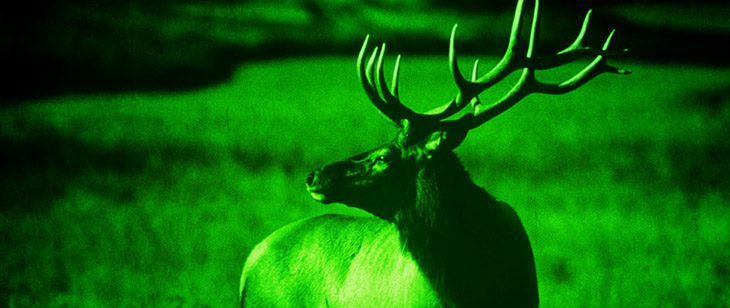
The first night vision devices were developed by a German electrical equipment company AEG, and some of their early prototypes saw limited usage during World War II. Night vision technology worked on the same fundamental principle for many years. Night vision scopes are usually big, so keep the weight of the optic in mind.
The comprehensive science lesson will be skipped, but the essential point is that dim light energy is combined with a little amount of thermal energy, and it goes through the objective lens then into the image intensifier tube. This tube turns photons of light into electrons, which are then amplified before they strike a phosphor-covered screen within the scope.
When the electrons strike the phosphors, they shine, and you see this lighted vision via the ocular lens, with magnification operating exactly the way it does on a regular scope.
If you are wondering why the image is green in a traditional night vision scope, it’s because when photons are turned into electrons, the image’s many hues are stripped away, leaving just black and white. The phosphors provide a green glow. Green is the easiest color to see in the dark for extended periods of time without creating eye strain.
Digital Night Vision
A modern night vision optic, whether night vision goggles or night vision scopes make use of digital imaging technology. Light in a digital night vision device is transformed into a digital signal with the same technology found in a digital camera. The digital picture is upgraded electronically, then amplified before being shown on an LCD screen.
Digital night vision scopes have transformed the industry, providing shooters with clear images, improved image detail, and higher build quality at reduced rates.
Night Vision Optic Technologies
There has been a massive improvement in night vision devices. We now have Night Vision Generations to distinguish between developments in night vision devices. We have from Generation 1 till Generation 3 and 4.
Night Vision Optic Brands
There are so many optic brands available, although some of the popular rifle scope companies do not use this technology. However, we may rely on several well-known firms that specialize in night vision optics that are good enough to illuminate our path. Here are some of the best night vision scope brands: ATN, Yukon, AGM Global, Sightmark, Firefield, Bering optics, and Pulsar.
Thermal Imaging Device
Thermal imaging gives humans the ability to view regions of the light spectrum that the naked eye cannot see. Light is nothing more than radiation. The electromagnetic spectrum’s radiation or beams have various lengths, which humans see as color.
The human eye can only see a limited section of this spectrum with lengths ranging between 400 and 800 nanometers. The infrared (IR) spectrum is a component of the spectrum that is invisible to the human eye when it comes to thermal imaging.
A thermal imaging device gives us the ability to see radiation released by people, objects, and animals, at any time of the day or night. This indicates that a thermal imaging device is “active,” as they do not require ambient light or artificial light to function.
Images give cool colors like varying degrees of blue when we use a thermal scope, thermal imaging monocular, or thermal goggle. Images with different shades of red depict heat emitted by living things, such as a human or an animal. The ability to notice this in complete darkness or in difficult terrain such as heavy trees may be quite useful in the field.
How Thermal Imaging Scope Works
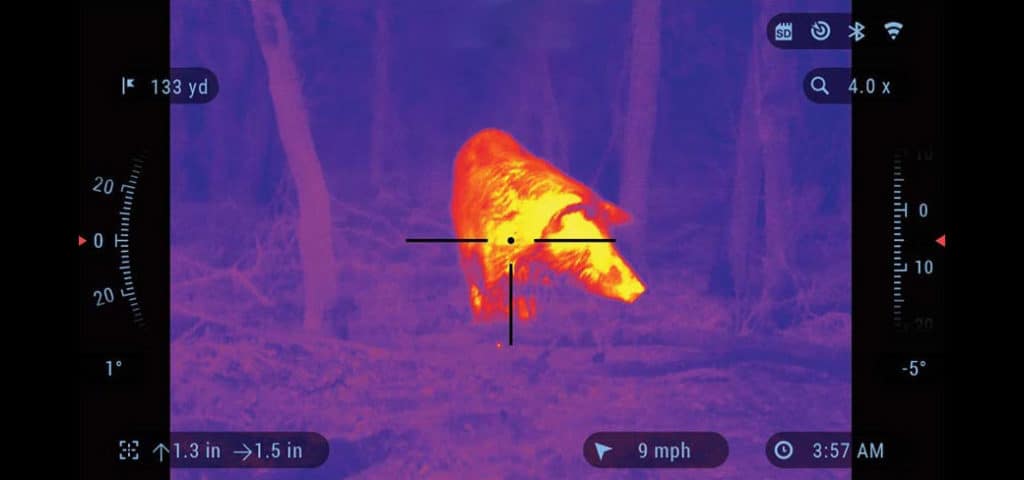
Thermal scopes emit a focused light – IR light that cannot be detectable by human eyes. The target area of the thermal scope is invisibly lighted up as internal components of the scope gather data to produce an electronic picture for the viewer. Here’s how it works:
The thermal scope starts by activating the IR detector elements, which then focus the infrared radiation energy on the target or object. The detector elements in the thermal scope quickly capture temperature data in the object or field of view. A Thermogram is created and then converted to electronic impulses. Electronic signals are then sent to a signal-processing unit.
The gathered data is sent to the display via the signal-processing unit. The display changes colors depending on the strength of the infrared light emission from the objects.
The journey starts from the objective lens of the thermal scope to the IR detector elements, the signal-processing unit, and finally, the display/eyepiece. There’s a lot happening at the same time between the objective lens and eyepiece; in the end, you’ll get a bright view even in a totally dark environment.
Thermal Device Technologies and Brands
There are two types of thermal imagers, cryogenically cooled thermal imaging and un-cooled thermal imaging. The un-cooled system is the standard system that is used in a rifle scope. A cryogenically cooled thermal device is a high-tech technology device.
Here are some of the best thermal scope brands that produce a thermal rifle scope, thermal monocular, and other thermal optics for night hunting and any other purpose: ATN, FLIR Systems, Bering optics, and Armasight.
ATN THOR LT 160 3-6X is an example of a thermal riflescope. It has a magnification range of 3 to 6 times of the human eyes. ATN THOR LT riflescope has other models with a different sensor and magnification.
What Is An Infrared Illuminator?
IR illuminator is like a flashlight that focuses Infrared radiation on a specific area. The infrared radiation is not visible to the naked eye. A thermal rifle scope can have an inbuilt infrared illuminator with an IR light range of up to 30 yards. There are other thermal scopes that require the assistance of an Infrared illuminator in conditions such as dark terrain and shaded forests. Thermal scopes that have a medium or long-range IR illuminator may also deliver IR light of up to 500 yards.
Does Thermal Imaging Scope Resolution Matter?
It certainly does! Because optics aren’t as important here as they are with non-IR scopes, you should be aware of how resolution variations influence your thermal imaging purchase.
A resolution of 240 x 180 will suffice. Moving up to a 320 x 240 resolution is even better. The best thermal scope resolution for portable optics is 640 x 480. Expect to pay a lot more if you want the best thermal scope with greater resolution.
Which is better for you: night vision or thermal optic?
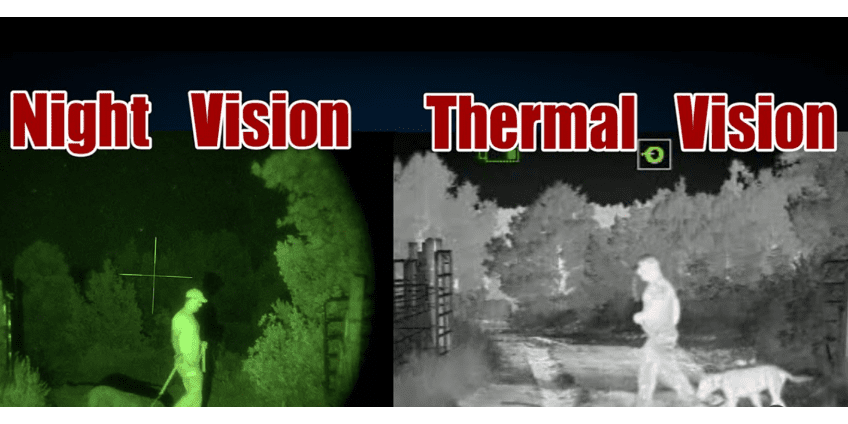
Night vision and thermal optic equipment are both considered night vision technologies. They just function in various ways. Night vision optics are termed “passive” because they require very little light to function.
Thermal scopes are termed “active” gadgets since they focus infrared light on the target region and do not require bright light to operate.
Let’s have the duel!
Identifying Game
While its image formation is dependent on ambient light, a detailed image is usually produced by a night vision scope to successfully distinguish and identify the game. A thermal scope, on the other hand, is great for spotting or detecting games, but it doesn’t offer definitive identification during night hunting.
In this scenario, a night vision scope with good resolution and picture quality is preferable to a thermal scope that may merely offer blobs of color.
Durability
Both scopes have long-lasting and dependable optics. Both scopes feature critical components that must be safeguarded and are capable of withstanding heavy recoils.
Dual Day Use
It may seem logical to say that a thermal scope and night vision scope would only be used at night when there is no bright light. However, there may be times when you require positive identification of your target regardless of lighting circumstances. Most night vision riflescopes are only suitable for use at night since intense light can be damaging to internal components, however, this is not always the case.
Some night vision scopes may now be used during the day as well. Thermal vision has the advantage in that they are more appropriate for dual usage because they do not require light to work. This means they can work in visible light and during night hunting.
Price
Night vision optics have been around for years, and they have been accessible to civilians longer than thermal imagers. As a result, night vision scopes are more affordable. Thermal imaging is a modern technology that was just made available to consumers, but they are still highly pricey.
Hunting Considerations
The debate between thermal riflescope and night vision will be determined by the type of habitat and conditions you intend to shoot in.
Are you hunting in a dense bush or tall grass, or at a great distance that necessitates more detection? Thermal vision makes it exceedingly easy to monitor and identify the heat signature of a target.
Do you hunt in areas prone to rain, fog, or cold temperatures? An NV scope is probably what you need.
As soon as it is sunset, you won’t be able to bag much game unless you have a thermal scope or an NV sight on your rifle.
FAQS
What is the main difference between thermal scopes and night vision devices?
Thermal scopes and night vision devices operate based on different principles. Night vision devices amplify available light, allowing users to see in low-light conditions. They work by capturing and intensifying the tiny amounts of light, including moonlight or starlight, to produce a visible image. On the other hand, thermal scopes detect the heat emitted by objects and convert it into a digital image. They don’t rely on light but instead, detect the temperature differences in the environment.
Can thermal scopes be used in complete darkness?
Yes, thermal scopes can be used in complete darkness. Since thermal scopes detect the heat signatures emitted by objects, they are not reliant on any ambient light source. They can “see” the variations in temperature and display the resulting image on the scope’s screen, allowing users to view their surroundings even in pitch-black conditions.
Are night vision devices affected by bright light sources?
Night vision devices can be affected by bright light sources. When exposed to intense light, such as car headlights or bright spotlights, night vision devices can experience temporary blindness or damage to their internal components. This is known as “blooming” or “halo effect,” where the bright light overwhelms the image intensifier tube and hampers visibility.
Which technology is better for hunting purposes?
The choice between thermal scopes and night vision devices for hunting purposes depends on the specific hunting environment and requirements. Both technologies have their advantages. Thermal scopes excel at detecting heat signatures, allowing hunters to track and spot animals, even in challenging conditions such as dense foliage or during low light situations. They are particularly useful in scenarios where visual camouflage might be employed by animals or when it’s necessary to track heat-emitting targets.
Night vision devices, on the other hand, provide enhanced visibility in low-light conditions by amplifying available light. They are suitable for identifying and distinguishing objects or animals more clearly. Night vision devices can be a good choice for hunting when there is some ambient light available.
Yes, thermal scopes have the ability to detect camouflage or hidden objects as long as they emit heat.
What are the key applications of thermal scopes?
Thermal scopes have various applications across different industries. Some key applications include hunting, surveillance and security, and search and rescue.
Are thermal scopes more expensive than night vision devices?
Yes, thermal scopes are generally more expensive than night vision devices. The technology used in thermal scopes involves detecting and interpreting heat signatures, which requires advanced sensors and processing capabilities. This contributes to the higher cost of thermal scopes compared to night vision devices, which amplify existing light sources. However, the prices of both thermal scopes and night vision devices can vary depending on the brand, features, and specifications.
Do thermal scopes require additional accessories for operation?
Thermal scopes typically do not require additional accessories for basic operation. They are standalone devices that capture and display thermal images. However, some users may choose to enhance their thermal scope experience with additional accessories, such as external infrared illuminators, which can improve visibility in extremely low-light conditions. Other optional accessories may include mounts, adapters, or protective cases, depending on individual needs.
How far can thermal scopes and night vision devices detect objects?
The detection range of both thermal scopes and night vision devices can vary depending on various factors, including the quality of the device, atmospheric conditions, and the size and temperature difference of the target object. Generally, thermal scopes have a longer detection range compared to night vision devices. In optimal conditions, thermal scopes can detect objects at distances ranging from a few hundred yards to several miles, depending on the specific model and environmental factors. Night vision devices typically have a shorter detection range, typically within a few hundred yards.

Mike Hardesty is a published freelance gun writer. He also possesses specialized expertise in rifle scopes With dozens of articles and reviews published in Pew Pew Tactical, Snipercountry.com, and TTAG (The Truth About Guns), Mike is considered a firearms expert. His special area of expertise is handguns.
Mike is a long-time shooter. He has been punching paper targets, taking deer and other game and shooting at competitions since about 1975. Other related pursuits include reloading and bullet casting. He currently reloads for over 10 calibers, both handgun and rifle. His reloads, particularly for 9mm, were in great demand during the height of the ammo shortage among family and friends. He donated hundreds of rounds to informal shooting sessions. He was quoted as saying “I do not sell my reloads but I sure will help my guys shoot ’em for free!”. He has a few cherished firearms that he has inherited or otherwise procured — those are his favorites.
He earned B.S. and M.S. degrees from Indiana State University in 1974-1975.
He’s a firearm experts and is the founder of mhardesty.com.
